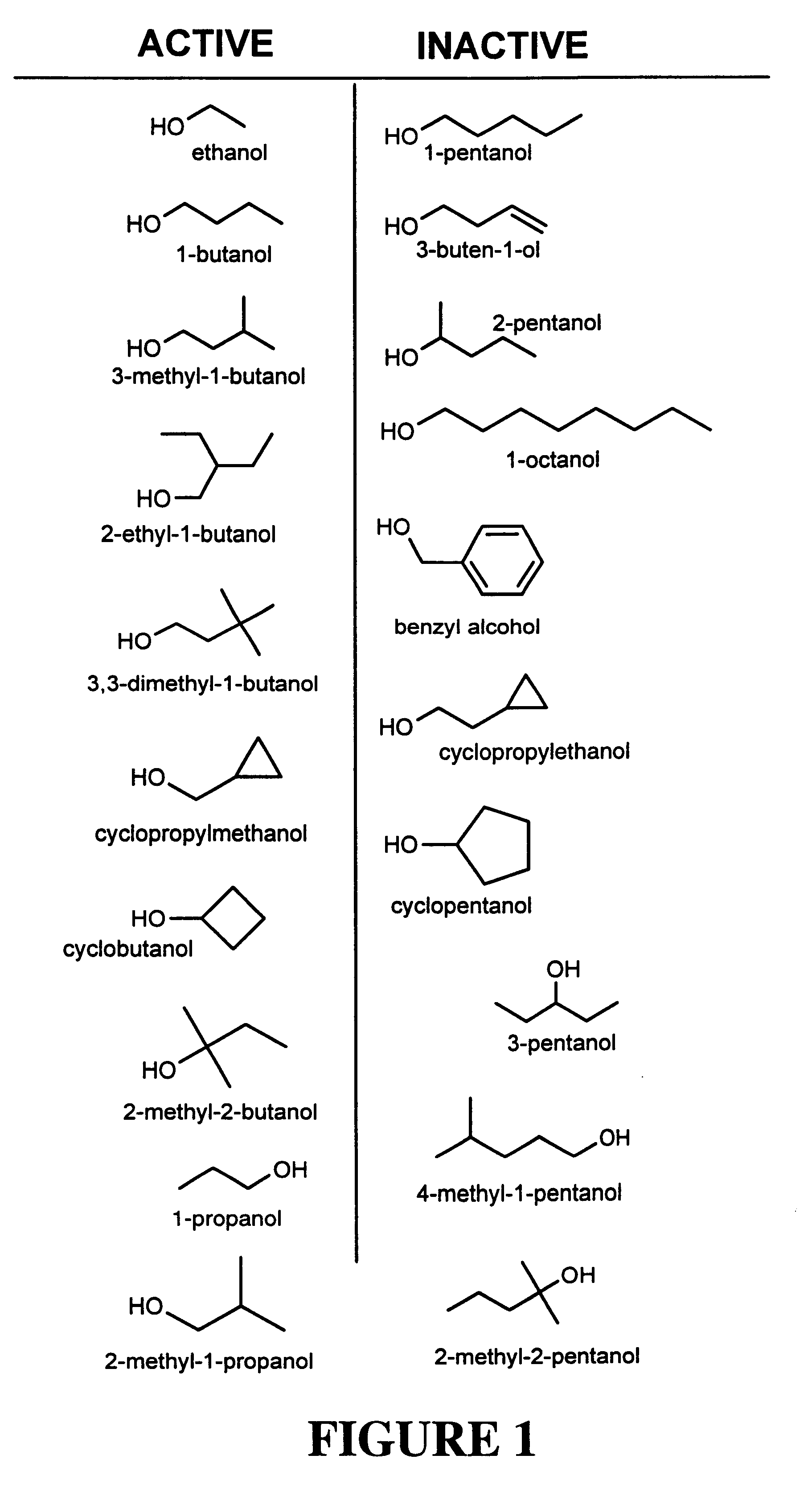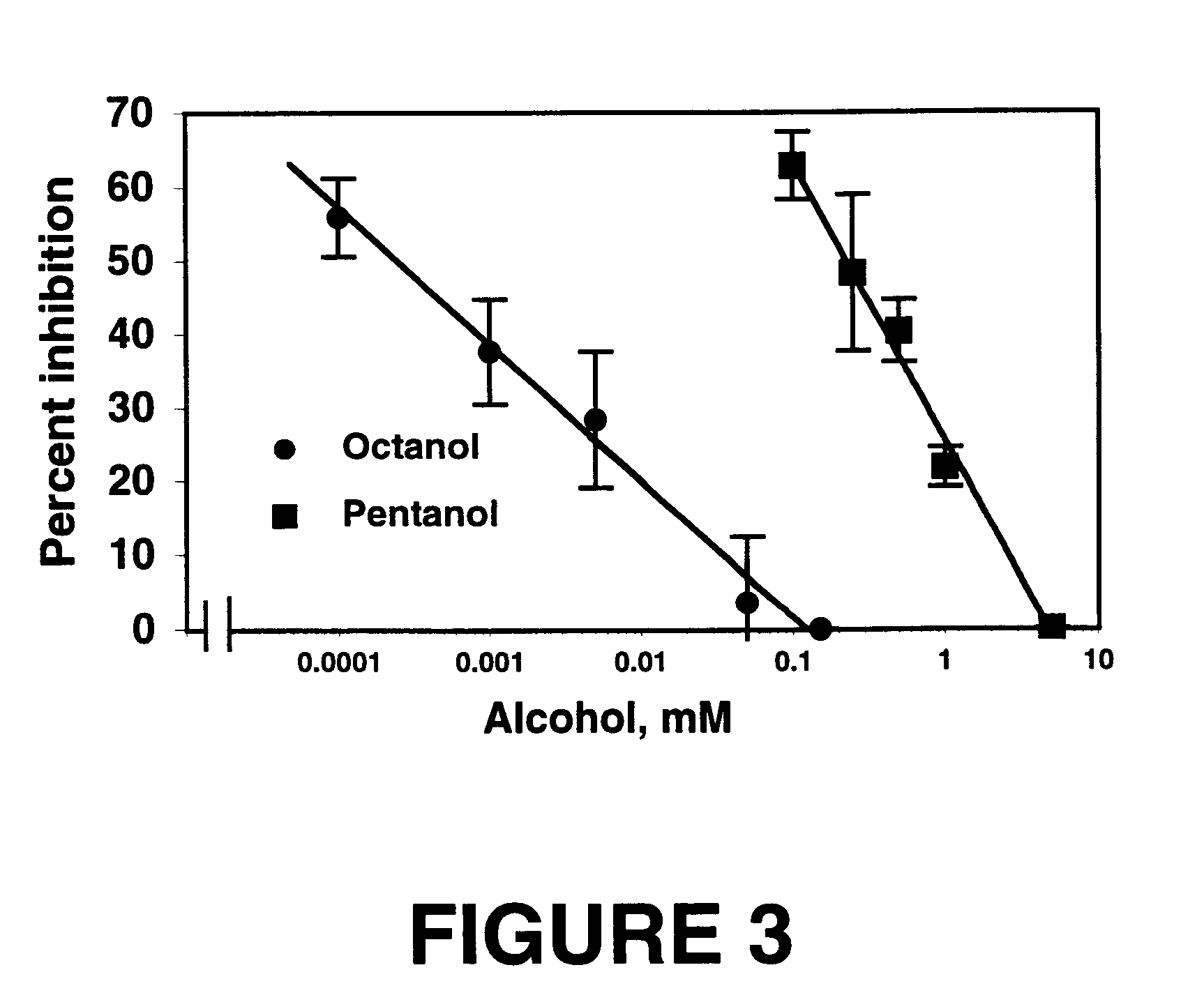Method for antagonizing inhibition effects of alcohol on cell adhesion
a technology of cell adhesion and inhibition effect, which is applied in the field of antagonizing the inhibition effect of alcohol on cell adhesion, can solve the problems of mental retardation, neurological disorders, costing the nation approximately $167 billion annually, etc., and achieves the effect of increasing the potency of cell adhesion and increasing the potency
- Summary
- Abstract
- Description
- Claims
- Application Information
AI Technical Summary
Benefits of technology
Problems solved by technology
Method used
Image
Examples
example 2
This example illustrates the effects of 1-alcohols on cell-cell adhesion in two model systems.
We tested the effects of a series of alcohols on cell-cell adhesion in two well-characterized model systems. NG108-15 cells were incubated for 48 hours in a serum-free medium supplemented with 10-20 ng / ml BMP-7 to induce L1 and N-CAM gene expression (Reference 10). Parallel experiments were performed using two ethanol-sensitive NIH / 3T3 cell lines transfected with human L1 (2B2-L1 and 2A2-L1) (Reference 12) and a NIH / 3T3 cell line transfected with the empty expression vector (1A5-V). FIG. 1 depicts the structures of the alcohols used in this invention and categorizes them as Active (inhibits cell-cell adhesion) or Inactive (no effect on cell-cell adhesion). For each alcohol tested, similar results were obtained in BMP-7 treated NG108-15 cells and in L1-expressing NIH / 3T3 cells (see Table 1 below).
Treatment with BMP-7 greatly increased the percentage of adherent NG108-15 cells (control, 17.0....
example 3
The following is an example of structure activity analysis of the alcohol target site.
We first examined alcohols related to 1-butanol, the 1-alcohol that most potently inhibited cell-cell adhesion. 2-Pentanol differs from 1-butanol through the addition of a methyl group at the 1-carbon position. This slight modification abolished activity (Table 1). In contrast, the addition of up to two methyl groups at the 2-carbon and 3-carbon positions of 1-butanol (2-ethyl-1-butanol; 3-methyl-1-butanol; and 3,3-dimethyl-1-butanol) did not reduce activity. Thus, we do not believe that alcohol activity is a simple function of molecular volume or the total number of carbons.
Modifications to the 4-carbon position of 1-butanol were also informative. 1-cyclopropylethanol differs from 1-butanol through the addition of a methyl group that bonds to both the 3-carbon and 4-carbon atoms to form a cyclopropyl moiety (FIG. 1). This modification abolished activity. To determine whether the inactivity of 1-cy...
example 4
The following is an example of an analysis of alcohols as multivalent ligands.
If alcohol action has strict structural requirements, then it is likely that potent alcohols, such as 1-butanol, must align with the target site in a specific orientation to inhibit cell-cell adhesion. Alcohols that present multiple 1-butanol moieties have a higher probability of aligning correctly with a 1-butanol recognition site and should, therefore, be more potent than 1-butanol.
FIG. 2 shows the structure of several multivalent alcohols related to 1-butanol. Dose response curves for the mean percent inhibition of cell adhesion in BMP-7 treated NG108-15 cells were calculated from 3-6 independent experiments. The IC.sub.50 was determined by log-logit analysis of the mean data. The number of alignments that can present a 1-butanol moiety to a target are depicted for each alcohol. Also illustrated in FIG. 2 is the membrane / buffer partition coefficient (P.sub.m / b) and molar volume (Vm) of each alcohol. It ...
PUM
| Property | Measurement | Unit |
|---|---|---|
| partition coefficient | aaaaa | aaaaa |
| partition coefficient | aaaaa | aaaaa |
| cell adhesion | aaaaa | aaaaa |
Abstract
Description
Claims
Application Information
 Login to View More
Login to View More - R&D
- Intellectual Property
- Life Sciences
- Materials
- Tech Scout
- Unparalleled Data Quality
- Higher Quality Content
- 60% Fewer Hallucinations
Browse by: Latest US Patents, China's latest patents, Technical Efficacy Thesaurus, Application Domain, Technology Topic, Popular Technical Reports.
© 2025 PatSnap. All rights reserved.Legal|Privacy policy|Modern Slavery Act Transparency Statement|Sitemap|About US| Contact US: help@patsnap.com



